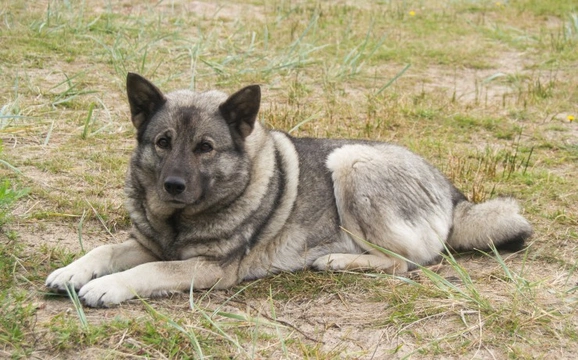
Dwarfism or chondrodysplasia DNA testing in the Norwegian elkhound dog breed
The Norwegian elkhound is far from being one of the most common dog breeds in the UK, being ranked way down in 205th place in the popularity stakes out of a total of 244 different dog breeds and types. However, there is a lot to recommend considering a dog of the breed if you are in the market for a new puppy – and can find a Norwegian elkhound breeder offering a litter for sale – and are seeking a medium-sized dog that is a good all rounder with lots of positive traits.
As the name implies, Norwegian elkhounds were originally bred to hunt elk in their native Norway and as such, dogs of the breed are sturdy and workmanlike animals that have bags of stamina and that are also bold and confident. Norwegian elkhounds share many of the core traits of other dogs of the spitz type, including a plush, thick coat, pointed ears, curled tails, and an inquisitive, outgoing nature.
Norwegian elkhounds are loyal and loving dogs that are very devoted to their families, and that are notable for getting on very well with children of all ages. They are also dedicated and reliable watchdogs, and are very smart dogs that are quick to learn new skills.
On the downside, Norwegian elkhounds tend to shed heavily like most spitz dogs, which means that they require a lot of grooming and coat maintenance. Dogs of the breed are usually quite long lived with an average lifespan of 12-15 years, but there are also a number of hereditary health issues that have been identified within the breed and that can be inherited by individual dogs.
One such issue is called chondrodysplasia, or dwarfism, which is caused by a genetic mutation that can be found within certain Norwegian elkhound bloodlines.
Chondrodysplasia in the Norwegian elkhound is a hereditary trait that can be passed on from parent dogs to their young if both parents carry a gene fault that leads to the affected form of the condition – even if the parent dogs are both normal size and are not affected by dwarfism themselves.
However, by means of undertaking a simple DNA test on prospective breeding stock, Norwegian elkhound breeders can determine the status of their parent dogs, and work out the status of any litter that a pairing of any two specific dogs would result in.
In this article we will look at chondrodysplasia or dwarfism in the Norwegian elkhound dog breed in more detail, as well as explaining how breeders can go about getting their breeding stock tested for the markers of the condition. Read on to learn more about dwarfism in the Norwegian elkhound dog breed.
What is chondrodysplasia or dwarfism in the Norwegian elkhound?
The word “chondrodysplasia” is a medical term for dwarfism, and it is a type of skeletal disorder. Norwegian elkhounds with chondrodysplasia will develop with limbs that are significantly shorter than the norm, and the condition may have a range of other effects on the dog’s skeletal development and conformation too.
These may include malformed femoral bone heads, abnormal development of the toes, and bowing of the forelegs too.
Chondrodysplasia in the Norwegian elkhound can be quite variable in terms of the degree of its severity in individual dogs, because the gene mutation that causes the condition affects the body’s collagen receptors whilst the bones are growing and developing, and the extent to which this occurs can lead to a very acute presentation in some dogs but a much more subtle effect in others.
How is chondrodysplasia passed from dog to dog?
Chondrodysplasia or dwarfism in the Norwegian elkhound is an autosomal recessive health condition, which means that it has to be inherited from parent dogs rather than caught or transmitted.
The status of both parent dogs combined rather than just one of the parent dogs is what dictates the status of any puppies they might have, and by finding out the status of your two prospective parent dogs, you can calculate the status of their future litter.
- Two clear dogs will have normal, unaffected puppies.
- Two affected dogs will produce a litter within which all of the pups inherit chondrodysplasia.
- Two carrier dogs will produce a mixed litter of 50% carriers, 25% clear and 25% affected.
- A clear dog and an affected dog will have a litter of carriers.
- A clear dog and a carrier will have a litter of 50% clear pups and 50% carriers.
- A carrier and an affected dog will have a litter of 50% carrier pups and 50% affected.
DNA testing for chondrodysplasia in the Norwegian elkhound
In order to enable Norwegian elkhound breeders to make informed mating matches that produce heathy litters, a DNA test can be undertaken to find out the status of any individual dog of the breed prior to breeding.
It is important to ensure that both parent dogs are tested for their status before going ahead with a mating match, as DNA input from both sides of the bloodline is what determines the status of the subsequent litter.
To get your dog DNA tested, you just need to let your vet know your plans and allow them to take a DNA sample from your dog to arrange this. The sample is then sent to an approved laboratory that can undertake the relevant test on it, to return a definitive result of the dog’s status.



